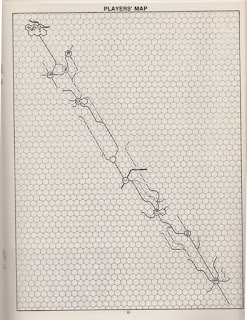Cepheus Engine ship combat card
Through fifty-six sessions of a Traveller campaign (specifically, a Cepheus-Engine-leaning-back-toward-classic-Traveller campaign), there's been relatively little ship combat. (Admittedly, there hasn't been a lot of personal combat either; a few sessions back, one player who's been there from the beginning made her first attack roll of the campaign. But it's an open table and her character had missed a number of previous violent altercations.) The rareness of ship-to-ship combat no doubt arises from the nature of our campaign — it centres on the crew of a 200-ton far trader — and the generally cautious choices of the players. In Traveller, which takes many cues from the Age of Sail, it's pretty easy to size up an enemy spacecraft from a distance: there's literally nowhere to hide in space. If it's bigger than yours, it probably has more guns, and your best option is to flee. There's no place for absurd D&Disms like PCs thinking, "Well, I'm 12th level so of course I'll have no problem taking on some colossal monster that can easily crush a regular person like an ant." In Traveller, you are regular people, so you'd best act accordingly. If you're on a small 200-ton ship with a single pulse laser, it means you're going to be running away a lot of the time.
But occasionally, you might choose to go head-to-head with another spaceship in the same weight class, as it were: a kind of featherweight ship duel. Such a thing happened several months back (in session 37, which you can read about in our campaign blog if you like) and, after the session, I thought about working up some simple cards to simplify record keeping during ship combat.
Cepheus Engine ship combat is pretty straightforward. You can run a duel between two ships by using each vessel's ship description, a paragraph of text that follows a standard format and provides all the relevant information about a ship. Unlike a stat block, it uses natural language; a non-gamer with only a modicum of sci-fi literacy could get a decent sense of the vessel from reading the description. The catch is that some of the numerical values embedded in the description will change during combat and, in addition, you'll have to track some conditions that arise as a result of taking damage. Suddenly that neatly formatted paragraph of text becomes rife with scribbles and strike-throughs and marginal notes about which systems are offline and how fast fuel is leaking and how badly the jump drive is compromised.
The rules for ship combat in CE are medium-crunchy. I'm not a fan of crunch for the sake of crunch but I found the Cepheus Engine procedures for ship combat provided satisfying narrative flavour and offered meaningful choices to the players. In each round — one kilosecond, or about 17 minutes — the crew has to decide how to manage time and resources: repair a damaged weapon or fix the maneuver drive? Line up a shot or close range to a target? Intercept enemy comms or mess with their sensors? You can't do it all, so you have to choose what seem to be the best options under the circumstances. Each weapon or component of a ship can take two hits; on the third, that component is destroyed. But the first and second hits impose disadvantageous conditions on those systems, so it's important to track those — you can't just tick them off like "hit points." Hence the need for some careful record keeping. The ship combat card is intended to ease that burden.
 |
| Cepheus Engine ship combat card (detail) |
The full version of the sheet places two cards side-by-side in landscape format, so everything you need to handle ship-vs-ship is on a single page.
 |
Feel free to grab the pdf from Google Drive. Hope you find it useful.

Comments